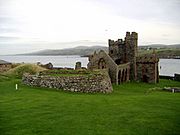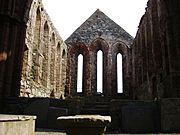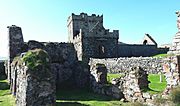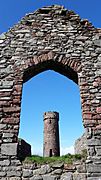Peel Castle facts for kids
Quick facts for kids Peel Castle |
|
|---|---|

Peel Castle as seen from the swing bridge at the entrance to Peel harbour
|
|
| General information | |
| Town or city | St Patrick's Isle, Peel |
| Country | Isle of Man |
| Construction started | 11th century |
| Completed | 1860 |
| Client | Magnus II of the Isle of Man |
| Design and construction | |
| Architect | Several |
Peel Castle (called Cashtal Phurt ny h-Inshey in Manx Gaelic) is a famous castle. It is located in Peel on the Isle of Man. Norwegians first built this castle.
The castle stands on St Patrick's Isle. A causeway connects this island to the town. Today, Manx National Heritage owns the castle. You can visit it during the summer months.
Contents
History of Peel Castle
Building the Castle
Norwegians built Peel Castle in the 11th century. King Magnus Barefoot ruled at that time. There were older stone buildings on the island. These were Celtic monastic buildings. But the first Norwegian defenses were made of wood.
The tall round tower was part of the old Celtic monastery. Later, battlements were added to it. In the early 1300s, most walls and towers were built. They used local red sandstone. This stone is common in the area.
From Church to Ruins
After Norwegian rule, the Church used the castle. This was because of the cathedral inside. It was the main church for the Diocese of Sodor and Man. But the castle was left empty in the 1700s.
The castle stayed a strong fortress. New defenses were added even in 1860. Most buildings inside the castle are now ruins. However, the outer walls are still standing.
Exciting Discoveries
Between 1982 and 1987, people dug up the castle grounds. They found a large graveyard. They also found parts of King Magnus Barefoot's first wooden fort.
One amazing find was a 10th-century grave. It belonged to "The Pagan Lady." Her grave held a beautiful Norwegian necklace. They also found silver coins from around 1030.
The Black Dog Ghost
Peel Castle has a famous "resident." It is a ghost called the Moddey Dhoo. This means "Black Dog" in Manx. Many stories are told about this mysterious ghost.
Peel Castle Today
Peel Castle is important to the Isle of Man. You can see it on the back of the £10 banknotes. These notes are issued by the Isle of Man Government.
Sometimes, people confuse Peel Castle with Piel Castle. Piel Castle is on Piel Island. It is located across the Irish Sea to the east. The poet William Wordsworth visited Peel Castle. He wrote about the Isle of Man many times.
Some people even think Peel Castle might be the legendary Avalon. This is a magical place from the stories of King Arthur.
Cathedral of St German Ruins
Inside Peel Castle, you can see the ruins of a cathedral. This was once the Cathedral of St German. Like other buildings in the castle, its roof is gone.
In 1877, Robert Anderson looked at the ruins. He wanted to see what repairs were needed. He told the island's Lieutenant Governor his ideas. But the repairs were never done.
There is a crypt below the main altar area. It has a pointed, arched ceiling. This crypt is about 34 feet long and 16 feet wide. It is 9 feet high at one end.
In the middle of the church's cross-shaped part, there is a tomb. Bishop Rutter was buried there in 1661. There is also a cemetery where the main part of the cathedral used to be.
In 1980, the church parish moved. The new Cathedral Church of St German opened. It is on Albany Road in Peel.
See also
 In Spanish: Castillo de Peel para niños
In Spanish: Castillo de Peel para niños







